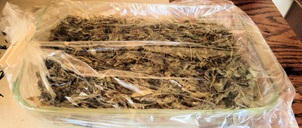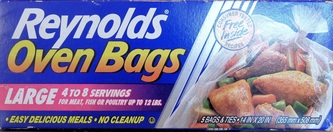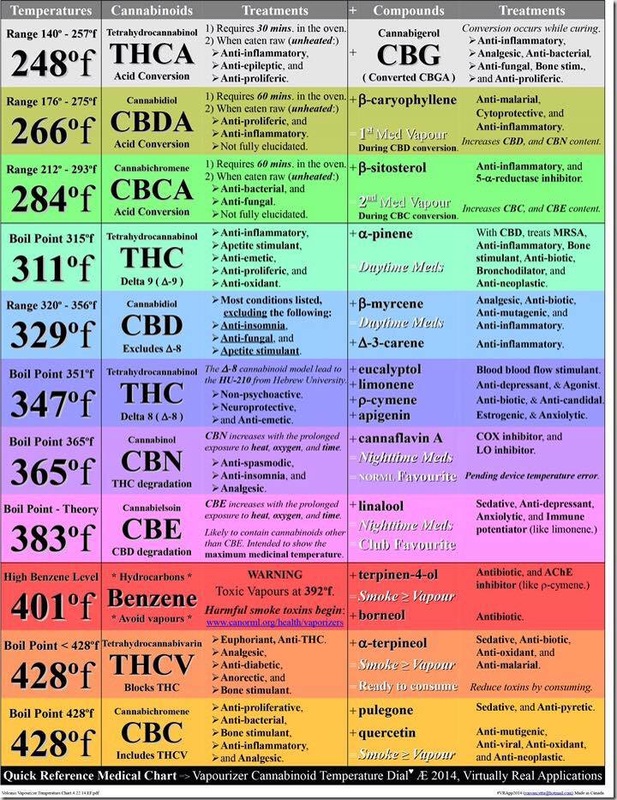
Raw cannabis contains mostly THC-A (THC Acid) and CBD-A (CBD Acid). Decarboxylation removes the carboxylic acid and converts THCA to THC and CBDA to CBD. Heating marijuana decarboxylates it. This is why smoking marijuana is more effective than eating the same amount of raw marijuana. We don’t have an enzyme that decarbs pot for us.
Initially this concept of decarboxylation would not stick in my unscientific mind. I forced myself to really pay attention; once I realized why I night want to do it. Most marijuana patients have the idea that if they don't feel a buzz from their medicine; it must not be any good. Of course I wanted others to think I made excellent medicine. I've since come to the conclusion that getting high is not a criteria for good medicine. Happily many of the patients I provide for have the same mind set as I do. I now choose to decarboxlate specifically for those wanting to be high while medicated or to obtain another goal like increasing the CBD content.
Cannabis must be decaroxylated if you’re making cannabutter or an oil infusion, tinctures, cannabis oil, etc. While THC-A and CBD-A have some healing effects, it’s overshadowed by THC and CBD. The former aren’t bioactive, the latter are.
To decarb cannabis, place dry material in a pre-heated oven. I use a Pyrex pie plate. Expect a 10% weight loss when you decarb (30 grams to 27 grams). I use a oven Thermometer to measure my heat finding that my oven isn't always what it says.
For the maximum THC heat it to 245° F for 45-60 minutes and for CBD 245° F for 60-90 minutes. Heat the cannabis in a covered glass pyrex casserole pan. When properly decarboxylated, the cannabis will be darker, dry, and crumble easily. Your kitchen will smell.
Some suggest decarbing longer to maximize CBD levels. Long as in 2-4 hours. Ideally, one would do two tests: one would measure time (15 minutes - 4 hours) and the other temperature (240 - 340).
The steps to decarboxlate are varied depending on who you read information from. I am a devotee to the Facebook page: Magical Butter Machine Users United. I check there often finding that many of the people there have vast amounts of knowledge and experience when it comes to how to process marijuana for really good medicines. Vance Grossi from that group suggested putting the broken up marijuana into a pryrex 9 x 13 baking dish and then covering the whole dish with a large baking bag. I closed mine up with a wooden clothes pin because of the very little bag I had available to tie a knot in or use another method.
Initially this concept of decarboxylation would not stick in my unscientific mind. I forced myself to really pay attention; once I realized why I night want to do it. Most marijuana patients have the idea that if they don't feel a buzz from their medicine; it must not be any good. Of course I wanted others to think I made excellent medicine. I've since come to the conclusion that getting high is not a criteria for good medicine. Happily many of the patients I provide for have the same mind set as I do. I now choose to decarboxlate specifically for those wanting to be high while medicated or to obtain another goal like increasing the CBD content.
Cannabis must be decaroxylated if you’re making cannabutter or an oil infusion, tinctures, cannabis oil, etc. While THC-A and CBD-A have some healing effects, it’s overshadowed by THC and CBD. The former aren’t bioactive, the latter are.
To decarb cannabis, place dry material in a pre-heated oven. I use a Pyrex pie plate. Expect a 10% weight loss when you decarb (30 grams to 27 grams). I use a oven Thermometer to measure my heat finding that my oven isn't always what it says.
For the maximum THC heat it to 245° F for 45-60 minutes and for CBD 245° F for 60-90 minutes. Heat the cannabis in a covered glass pyrex casserole pan. When properly decarboxylated, the cannabis will be darker, dry, and crumble easily. Your kitchen will smell.
Some suggest decarbing longer to maximize CBD levels. Long as in 2-4 hours. Ideally, one would do two tests: one would measure time (15 minutes - 4 hours) and the other temperature (240 - 340).
The steps to decarboxlate are varied depending on who you read information from. I am a devotee to the Facebook page: Magical Butter Machine Users United. I check there often finding that many of the people there have vast amounts of knowledge and experience when it comes to how to process marijuana for really good medicines. Vance Grossi from that group suggested putting the broken up marijuana into a pryrex 9 x 13 baking dish and then covering the whole dish with a large baking bag. I closed mine up with a wooden clothes pin because of the very little bag I had available to tie a knot in or use another method.
He suggested to bake the dish at 225 degrees for 15 minutes and then to bake at 240 degrees for an additional 45 minutes. He is a very mindful marijuana processor, so I went with what he suggested. Also after baking, keep the bag closed and cool for 1 hour. After it is cooled, place in the freezer for 24 hours. When you freeze cannabis buds, those potent little trichomes become like tiny icicles. This makes them stiff and brittle and actually makes them fall off and break off the buds. The more you handle the buds in and out of the freezer, the more you lose those active ingredients that help alleviate the symptoms you are trying to address. You do not want to loose those trichomes, but you do want to make it possible for them to easily be infused into your oil.
Decarbing smells. Be forewarned and plan ahead. When done properly the cannabis will be dark and crumbly. I actually find that keeping it in the bag and not opening it while still warm kept the kitchen not becoming a total overwhelming dank smelly place that I expected.
Because decarboxylating evaporates the terpenes, terpenoids, and other aromatics, I use 50% as much raw cannabis as decarbed. It’s much like finishing hops when making beer. I strive for what I call a cannabinoid cocktail, a.k.a. the Entourage Effect, a deliberately whole plant extraction process.
Source: http://leblanccne.com/decarboxylation/
Vance Grossie:when converting CBD..just be careful because you will turn your THC into CBN also and it takes far less CBN to give you sedative effects..so if it has a THCA amount it will probably convert to CBN with the CBD..another words you will sleep...
If you have further questions, please ask me. I am willing to find more data that might make this decarbing easier to understand.
Because decarboxylating evaporates the terpenes, terpenoids, and other aromatics, I use 50% as much raw cannabis as decarbed. It’s much like finishing hops when making beer. I strive for what I call a cannabinoid cocktail, a.k.a. the Entourage Effect, a deliberately whole plant extraction process.
Source: http://leblanccne.com/decarboxylation/
Vance Grossie:when converting CBD..just be careful because you will turn your THC into CBN also and it takes far less CBN to give you sedative effects..so if it has a THCA amount it will probably convert to CBN with the CBD..another words you will sleep...
If you have further questions, please ask me. I am willing to find more data that might make this decarbing easier to understand.




 RSS Feed
RSS Feed